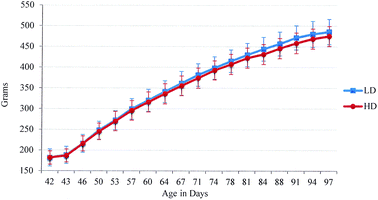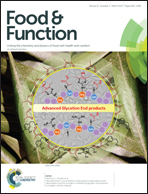A diet containing a high- versus low-daidzein level does not protect against liver steatosis in the obese Zucker rat model
Abstract
The prevalence of obesity is increasing worldwide. Obesity increases the risk for non-alcoholic fatty liver disease through adipokine dysregulation and inflammation. Previously, we have reported that a high-isoflavone soy protein isolate (HISPI) diet is associated with significantly heavier body weights and reduced liver steatosis in obese Zucker rats (OZR) compared to a casein diet. The objective of this study was to investigate whether daidzein, a soy isoflavone in HISPI, is responsible for increased body weight gain or reduced liver steatosis. We hypothesized that a casein diet containing high daidzein (HD) compared to low daidzein (LD) would mitigate hepatic steatosis in female OZR. We used 19 five-week-old female OZR (fa/fa). Rats were randomly assigned to a modified AIN-93G diet containing HD (0.121 g kg−1 feed) or LD (0.01 g kg−1 feed). Rats were weighed twice weekly. Feed intake was measured once weekly, and kcal per kg of body weight was calculated. After 8 weeks, rats were sacrificed. Serum and livers were collected. Sections of the liver lobe were fixed in 10% buffered formalin and stained with hematoxylin and eosin. Steatosis was semiquantitated as a score of 1 to 4 based upon the relative degree of steatosis within hepatocytes: (1) <25%, (2) 25%–50%, (3) 50%–75%, and (4) >75%. Serum leptin and adiponectin were measured by ELISA. Our results did not show significant differences in mean liver steatosis scores, body weights, energy intake, and serum leptin and adiponectin levels between diet groups. In conclusion, daidzein may not be the main component of HISPI responsible for increasing body weight or reducing liver steatosis in OZR.



 Please wait while we load your content...
Please wait while we load your content...